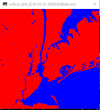I've run into a really strange error today. The attached namelist.input file works when run from 0Z on May 1st through 0Z on May 8th 2018. However, when I try to run the next week (re-initializing the run instead of using restart files as I had previously since that continuously built up a larger cold bias over time) it simply fails. There is no error message that can found, no fatal call. It just quits 3 minutes into the run when it begins to iterate. I have tried using different dates for the 2nd week (the attached file is my attempt at making 5 day runs instead of 7) but it does nothing. There is an odd bug when using WRF Urban where the restart_interval and history_interval are linked and you need very frequent restart files if you want history output to have decent temporal resolution (on May 1st a 3 hour restart_interval causes WRF to fail running, but a 2 hour restart does not when the history interval is 60 minutes), but changing those values does nothing here (I've tried reducing restart_interval to 30 minutes and increasing history_interval to 120 minutes at the same time, no change). Changing the time_step or radt also appears to have no impact (at least not when trying to run the 2nd week), so right now I'm stumped (turning off the urban model does let it work which is how I know the problem is related to it, but I need it on). It's super odd that this configuration works, and then it doesn't.
I'm running this set of simulations using NAM12K analysis data and NLCD 2011 land use data. Other additions I make have no impact on whether WRF will run or not- attempting to run wrf.exe immediately after the completion of real.exe still fails.
Feb 1 edit: The attached namelist doesn't actually work when run on the first week of May, but changing the timestep from 60 to 48 allows it to run with restart_interval of 120 or 180 (but it still fails when run at other dates, I even got a "Flerchinger USEd in NEW version. Iterations = 10" output when trying to run the 3rd week of May)
I'm running this set of simulations using NAM12K analysis data and NLCD 2011 land use data. Other additions I make have no impact on whether WRF will run or not- attempting to run wrf.exe immediately after the completion of real.exe still fails.
Feb 1 edit: The attached namelist doesn't actually work when run on the first week of May, but changing the timestep from 60 to 48 allows it to run with restart_interval of 120 or 180 (but it still fails when run at other dates, I even got a "Flerchinger USEd in NEW version. Iterations = 10" output when trying to run the 3rd week of May)
Attachments
Last edited:



